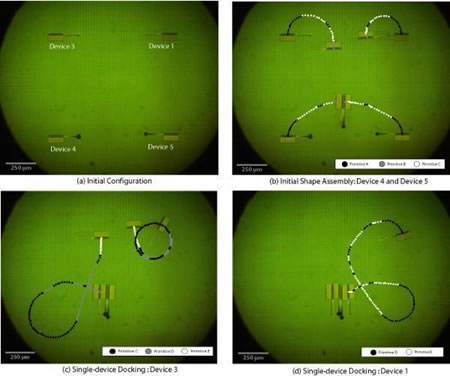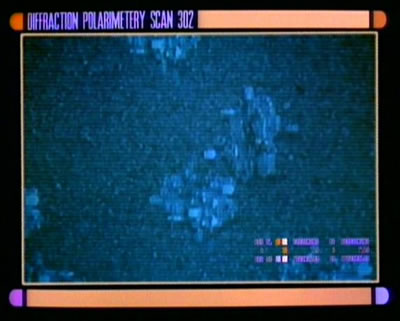Science Fiction
Dictionary
A B C D E F G H I J K L M N O P Q R S T U V W X Y Z
Untethered Microrobots Dance, Form Self-Organized Structures

Microrobots form self-organized structures after years of research by Bruce Donald, a Duke professor of computer science and biochemistry, and a team of researchers. Each spatula-shaped microrobot is just 250 microns long.

Microrobots at work
(The robots are initially arranged along the corners of a rectangle with sides 1 by 0.9 mm. The assembly experiment is divided into three stages. During stage 1, devices 4 and 5 dock together to form the initial stable shape. In stage 2, device 3 docks with the initial stable shape, while during stage 3, device 1 docks with the stable shape, forming the final assembly.)
Here's how the microrobots move and self-assemble:
Propelling themselves across such surfaces in an inchworm-like fashion impelled by a "scratch-drive" motion actuator, the microrobots advance in steps only 10 to 20 billionths of a meter each, but repeated as often as 20,000 times a second.The microrobots can be so small because they are not encumbered by leash-like tethers attached to an external control system. Built with microchip fabrication techniques, they are each designed to respond differently to the same single "global control signal" as voltages charge and discharge on their working parts.
This global control is akin to ways proteins in cells respond to chemical signals, said Donald, who also uses computer algorithms to study processes in biochemistry and biology.
Here's a video from the 2006 work showing just one microrobot.
Untethered Microrobot video
(Steerable, electrostatic, untethered, MEMS micro-robot, with dimensions of 60 µm by 250 µm by 10 µm. This micro-robot is 1 to 2 orders of magnitude smaller in size than previous micro-robotic systems. The device consists of a curved, cantilevered steering arm, mounted on an untethered scratch drive actuator.)
It placed a miniaturized nest of embryonic robots, no larger than pinheads, within the card file, then a tiny find-circuit transmitter behind a subsequent card, then at last a potent detonating device set on a three-day command circuit.
(Read more about Philip K. Dick's embryonic robots)
Star Trek TNG fans might be thinking about the nanites that Wesley Crusher was playing with aboard the Enterprise.

(Star Trek: TNG EVOLUTION nanites)
I've been working on my final project for Advanced Genetics. It’s on nanotechnology. I've been studying the nanites we have in the Sickbay genetic supplies. They're these little tiny robots with gigabytes of mechanical computer memory.(Star Trek: TNG, 1989)
Via ScienceDaily; thanks to Moira for pointing this story out.
Scroll down for more stories in the same category. (Story submitted 6/8/2008)
Follow this kind of news @Technovelgy.| Email | RSS | Blog It | Stumble | del.icio.us | Digg | Reddit |
Would
you like to contribute a story tip?
It's easy:
Get the URL of the story, and the related sf author, and add
it here.
Comment/Join discussion ( 1 )
Related News Stories - (" Robotics ")
Golf Ball Test Robot Wears Them Out
"The robot solemnly hit a ball against the wall, picked it up and teed it, hit it again, over and again...' - Frederik Poh, 1954.
PaXini Supersensitive Robot Fingers
'My fingers are not that sensitive...' - Ray Cummings, 1931.
Artificial Skin For Robots Is Coming Right Along
'... an elastic, tinted material that had all the feel and appearance of human flesh and epidermis.' - Harl Vincent (1934)
Robot Guard Dog On Duty
I might also be thinking of K-9 from Doctor Who.
Technovelgy (that's tech-novel-gee!) is devoted to the creative science inventions and ideas of sf authors. Look for the Invention Category that interests you, the Glossary, the Invention Timeline, or see what's New.
Science Fiction
Timeline
1600-1899
1900-1939
1940's 1950's
1960's 1970's
1980's 1990's
2000's 2010's
Current News
Golf Ball Test Robot Wears Them Out
"The robot solemnly hit a ball against the wall, picked it up and teed it, hit it again, over and again...'
Boring Company Vegas Loop Like Asimov Said
'There was a wall ahead... It was riddled with holes that were the mouths of tunnels.'
Rigid Metallic Clothing From Science Fiction To You
'...support the interior human structure against Jupiter’s pull.'
Is The Seattle Ultrasonics C-200 A Heinlein Vibroblade?
'It ain't a vibroblade. It's steel. Messy.'
Roborock Saros Z70 Is A Robot Vacuum With An Arm
'Anything larger than a BB shot it picked up and placed in a tray...'
A Beautiful Visualization Of Compact Food
'The German chemists have discovered how to supply the needed elements in compact, undiluted form...'
Bone-Building Drug Evenity Approved
'Compounds devised by the biochemists for the rapid building of bone...'
Secret Kill Switch Found In Yutong Buses
'The car faltered as the external command came to brake...'
Inmotion Electric Unicycle In Combat
'It is about the size and shape of a kitchen stool, gyro-stabilized...'
Grok Scores Best In Psychological Tests
'Try to find out how he ticks...'
PaXini Supersensitive Robot Fingers
'My fingers are not that sensitive...'
Congress Considers Automatic Emergency Braking, One Hundred Years Too Late
'The greatest problem of all was the elimination of the human element of braking together with its inevitable time lag.'
The Desert Ship Sailed In Imagination
'Across the ancient sea floor a dozen tall, blue-sailed Martian sand ships floated, like blue smoke.'
The Zapata Air Scooter Would Be Great In A Science Fiction Story
'Betty's slapdash style.'
Thermostabilized Wet Meat Product (NASA Prototype)
There are no orbiting Michelin stars. Yet.
Could Crystal Batteries Generate Power For Centuries?
'Power could be compressed thus into an inch-square cube of what looked like blue-white ice'
